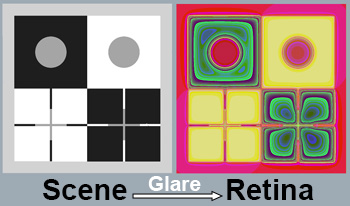
Glare introduces a complex scene-depended transformation of the array of “All Scene Luminances” making a different spatial pattern in the array of light on all receptors, called “Retinal Contrast”. The spatial convolution of “All Scene Luminances” with Vos and van den Berg’s CIE 1999 Glare Spread Function calculates high-resolution arrays of “Retinal Contrasts”. The results show that uniform-luminance scene segments become low-slope gradients that are nearly invisible, or invisible. Visual inspection of these arrays is misleading. Plots of calculated “Retinal Contrast” values, histograms, and other numerical techniques are needed to analyze the effects of glare. Pseudocolor Look-up Tables (LUT)s are very helpful in visualizing the complexity of glare’s spatial transformation that controls the amount of light falling on rods and cones. This article studies Lightness Illusions that contain two identical scene-luminance segments that are identified as the “Regions-Of-Interest”(ROI). Following receptor responses, neural spatial processes generate a second spatial-image transformation that leads to appearances. Contrast, Assimilation, and Natural Scene Illusions demonstrate [Appearance ≠ scene luminance]. Analysis of Illusion’s patterns of light on receptors shows that: Contrast Illusions, Edwin Land’s B&W Mondrian, Adelson’s Checkershadow all exhibit Glare’s Paradox. Namely, that vision’s second neural transformation overcompensates the effects of glare. Illusions’ GrayROIs appear darker despite large amounts of glare light on receptors. GrayROIs that appear lighter have smaller amounts of glare. Assimilation Illusions adds light to GrayROI’s that appear lighter. The combination of intraocular glare and Lightness Illusions shows complex-spatial-image-processing transformations following receptor responses in normal scenes.
John McCann, "Pseudocolor Analysis of Glare’s Paradox in Illusions" in Color and Imaging Conference, 2022, pp 69 - 74, https://doi.org/10.2352/CIC.2022.30.1.14
 Find this author on Google Scholar
Find this author on Google Scholar Find this author on PubMed
Find this author on PubMed